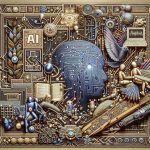The 2024 Global Robot Conference recently showcased an impressive array of cutting-edge industrial robots that captivated visitors. Alongside, the establishment of Beijing’s first artificial intelligence standardization research institute marks a significant milestone for the city, furthering its ambition to develop a comprehensive ecosystem for the robotics industry.
Beijing is vigorously pursuing its vision of becoming a leading artificial intelligence city. The initiative emphasizes a robust innovation system that spans algorithm breakthroughs to industry transformation. Efforts are underway to integrate AI technologies deeply into urban development and industrial upgrades, aiming to create a world-class hub for embodied intelligent robots.
In this thriving environment, various robotics companies benefit from proximity. They can seamlessly collaborate on research, manufacturing, training, testing, and application processes. Recent advancements include the world’s first full-sized electric humanoid robot and a groundbreaking AI-assisted surgical robot, showcasing Beijing’s leadership in both humanoid robotics and medical applications.
Among the participants, innovative companies have significantly advanced joint technology for robotic joints, enabling greater flexibility reminiscent of human movement. This is exemplified by a newly launched surgery robot that utilizes AI deep learning to enhance surgical precision dramatically.
Moreover, Beijing is home to top-tier testing facilities that provide comprehensive services across the industrial robotics spectrum. As it continues to foster innovation and collaboration, Beijing is poised to emerge as a global leader in the robotics industry. With strategic plans aimed at expanding application scenarios and enhancing technological capabilities, the capital’s robotics sector is on track to redefine industrial standards both nationally and internationally.
New Innovations in Robotics: Beijing’s Emerging Hub
In recent years, Beijing has solidified its position as a burgeoning center for robotics, driven by rapid technological advancements and a supportive policy environment. As the city invests heavily in research and development, several notable innovations are positioning it as a leader on the global stage.
What are the key innovations being developed in Beijing’s robotics sector?
One of the significant breakthroughs is the integration of 5G technology with robotics, enabling enhanced communication and real-time data processing. This innovation allows for remote control and automation of robots, which is proving invaluable in sectors such as logistics and construction. Additionally, the use of machine learning algorithms has enhanced the functionality of robotics, enabling machines to learn from their environments and improve over time, further increasing efficiency and adaptability.
Which industries are most impacted by robotics innovations in Beijing?
The healthcare sector has been particularly transformed by robotics innovations. In addition to surgical robots, there are now rehabilitation robots designed to assist patients recovering from surgeries or injuries. Furthermore, the agricultural sector is embracing robotics with autonomous farming equipment, improving crop management and efficiency, addressing labor shortages, and promoting sustainable practices.
What are the key challenges associated with these innovations?
Despite the promising developments, several challenges persist. Ethical concerns surrounding the use of autonomous systems, particularly in defense and surveillance, raise issues about accountability and security. Moreover, the rapid pace of technological advancement may outstrip regulatory frameworks, leading to gaps in safety protocols and standards.
What are the advantages and disadvantages of this robotics revolution?
The advantages include a substantial increase in productivity, efficiency, and precision across various industries. This can lead to cost reductions and improved quality of life through advanced healthcare solutions. However, the disadvantages encompass the potential for job displacement due to automation and the considerable amount of investment required for research and development, which may deter smaller companies from entering the market.
What is the future outlook for Beijing as a robotics hub?
Looking ahead, Beijing is expected to continue fostering partnerships between government, academia, and industry. The city aims to enhance its talent pool through educational programs and initiatives that emphasize STEM (Science, Technology, Engineering, and Mathematics) education. The establishment of more robotics incubators and accelerators will likely give rise to a new generation of startups, further propelling innovation.
In conclusion, as Beijing gears up to become a world leader in the robotics field, it stands at the forefront of technological innovation and industrial evolution. The city’s strategic initiatives, coupled with groundbreaking research, position it as a hub of excellence that could redefine productivity across multiple sectors globally.
For more information on Beijing’s technological initiatives and the impact of robotics, visit China Daily and South China Morning Post.


















